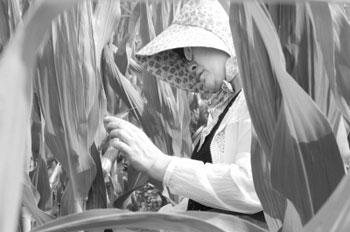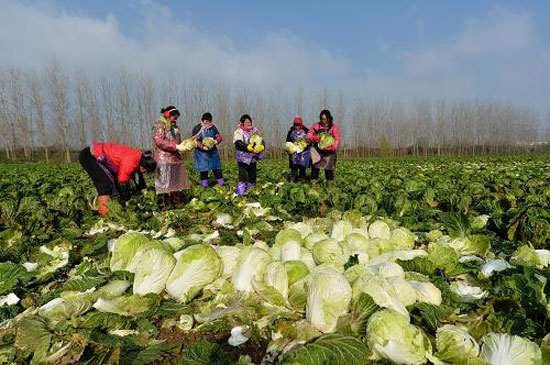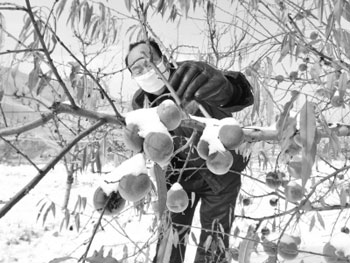The automatic prediction of diseases and insect pests in the whole process is accurate and fast.
Original title: how are diseases and insect pests predicted?
Monitor the "counting bug" model and "calculate the trend"

When it comes to disease and pest forecasting, the traditional concept of the scene is often forecasters holding a small book, standing in the field counting insects, but modern plant protection has already entered the information stage. Automatic data transmission, intelligent analysis and informationization make the monitoring and early warning of diseases and insect pests more accurate and timely, which plays a greater role in reducing disaster losses and ensuring food security.
"the overall occurrence of diseases and insect pests is heavy this year."it is expected that the overall occurrence of diseases and insect pests in the middle and later stages of late rice this year will be more serious."... Behind every seemingly simple forecast result, there is a lot of data acquisition and analysis--
-- tracking the "whole process" of the occurrence of diseases and insect pests
Li Jinghan, a reporter from our newspaper
Collection
From the forecaster counting bugs one by one to remote automatic real-time monitoring
The number is one of the main indicators to judge the epidemic degree of diseases and insect pests. Liu Wancai, director of the Disease and insect Pest reporting Office of the National Agricultural Technology extension Service Center, told the reporter that in the past, if you wanted to know how many insects there were, you could only check by the forecaster alone. When diseases and insect pests occur, there may be hundreds of thousands of insects in one night, and the work is intensive. Data is also easy to lose. Now the application of modern information technology, such as the Internet of things and computers, makes the automatic collection of monitoring data a reality.
Automatic worm alarm lamp is one of the latest "magic weapons" of grass-roots forecasters. Although the appearance is the same as the insecticidal lamp used for prevention and control, the lure is completely different. The measuring lamp requires a balanced release rate of the sex attractant to ensure the accuracy of the count. It can automatically count the number of worms, and the data can be read anytime and anywhere. There is also a remote real-time monitoring system, which can be said to be the "clairvoyance" of the forecaster, which can reproduce the field scene in real time and monitor the field situation at any time without being on the spot.
The automation of monitoring not only saves time and effort, but also has higher accuracy. Potato late blight is the first successful example of automatic real-time monitoring of crop diseases and insect pests in China. At present, the annual area of potato late blight in China is 3000 ~ 40 million mu, accounting for about 40% of the planting area, which can cause 70% to 80% yield loss in serious cases. Field humidity and temperature are the most important meteorological conditions that determine the occurrence and epidemic of late blight. Real-time monitoring of field climate can effectively guide the prevention and control of late blight.
"the core equipment of automatic real-time monitoring is a small field climatometer." Liu Wancai said that the climatometer can collect all kinds of meteorological factors in the field (air temperature and humidity, soil temperature and humidity, illuminance, rainfall, evaporation, air pressure, wind speed, and wind direction) in real time, and automatically transmit, store, and analyze them statistically. Combined with the epidemic law of late blight, a prediction model is established, and the epidemic situation can be predicted more accurately.
At present, the technology has been demonstrated and popularized in Chongqing, Gansu, Guizhou, Inner Mongolia and other provinces and regions, realizing automatic network transmission of monitoring data and simulated early warning. Late blight epidemic in Gansu Province for two consecutive years in 2012 and 2013, the plant protection department used digital monitoring and early warning system combined with field investigation to effectively improve the timeliness and accuracy of the forecast.
Analysis.
The conditions of Henan and Shandong in the second year were obtained from the wheat stripe rust plants in Gansu.
Accurate prediction is the basis of pest control, but how to predict the occurrence of diseases and insect pests in advance? Liu Wancai said that the secret lies in the monitoring and prediction model of diseases and insect pests.
Stripe rust is a major disease of wheat, which occurred three times in the history of New China, resulting in a grain loss of 6 billion kg in 1950, equivalent to a 45% reduction in production, 3.2 billion kg in 1964 and 1.2 billion kg in 1990. Now, the loss has been successfully controlled at 200-300 million kg per year.
The reason why stripe rust can be "subdued" is precisely because the epidemic law of stripe rust has been found out and a prediction model has been established. Stripe rust spread in China successively through over-summer variable areas, winter breeding areas and spring epidemic areas, of which the main over-summer areas are in Longnan of Gansu and northwest of Sichuan, and reach winter breeding areas such as Hubei, southern Hunan and Guanzhong of Shaanxi in autumn. No loss will be caused in these two areas, and the epidemic did not begin to spread until the next spring in Henan, Shandong and other major wheat-producing areas. Therefore, by mastering the early transmission situation such as over-summer areas, we can basically understand how to control stripe rust in the main wheat producing areas in the coming year.
Combined with climatic factors and epidemic law, we can also carry out dynamic monitoring and early warning of migratory pests. For example, rice planthopper and rice leaf roller generally flew into China from Vietnam and Laos from April to May, and first "landed" in South China, Jiangnan and southwestern rice regions, and then migrated northward. Therefore, in March every year, Guangdong, Guangxi, Fujian and other places will begin to monitor the pest situation in order to do a good job in the prevention and control of rice diseases and insect pests in the country.
In addition to empirical prediction based on laws, it is also important to analyze data through computer models. With the introduction of Geographic Information system (GIS), the changing trend of diseases and insect pests has a more scientific and intuitive method.
"through GIS, we can directly deduce the dynamics of the occurrence of diseases and insect pests in the coming week." Liu Wancai showed to reporters on the computer that on the computer screen was a map of the country, which marked the severity of diseases and insect pests in different areas through different colors. Pulling a horizontal line on the map is like rolling up a shutter, and the changing trend of diseases and pests is clear at a glance: darker areas will be more serious in the future, while lighter ones will be reduced.
Publish
From the old Telegraph machine in the 1980s to today's mobile phone
Liu Wancai has been engaged in disease and pest forecasting for more than 20 years. From the beginning of his career to the present, he has a feeling of "changing shotguns for guns."
In the 1980s, in order to report diseases and insect pests more quickly, an old Telegraph machine was standard at every measuring and reporting station, and each piece of data had to check the telegram code one by one. From 1996 to 1998, the computer network transmission and management system of disease and pest prediction information was opened. Although it is still telephone dial-up, the disease and pest information can also be transmitted through the network. From 2003 to 2005, crop pest monitoring information system was developed. At the end of 2009, a more practical digital monitoring and early warning system for major diseases and insect pests was put into operation, using the combination of online reporting and mobile reporting, no matter where the forecaster is, as long as there is a mobile phone to upload disease and pest information in real time.
At present, there are 6176 items in 151 reports of the monitoring and early warning system, of which 831 items are calculated automatically by the system. "in the past, a lot of valuable historical data have not been accumulated, and disease and pest prediction models cannot do without the data." Liu Wancai said: from 2000 to 2014, a database for the measurement and forecast of diseases and insect pests of rice, wheat, cotton, and corn has been built, with more than 1.2 million tables and more than 15 million data; and information on the occurrence and control of major diseases and insect pests from 2009 to 2014 has been stored in the database, realizing the automatic processing and comparison of the inter-annual data system.
"We have eight or nine large servers dedicated to data storage, display and pest detection, and we have rented 50m dedicated optical fiber and a special backup system to ensure data security." Liu Wancai is very proud to mention this.
The timely release of early warning information on major diseases and insect pests is also very important. "the forecast should be issued at the right time, neither too early nor too late." Liu Wancai said. Before 2000, the release of information was mainly based on paper media. After 2000, radio and television were introduced. In recent years, the application of new media such as the Internet, mobile phones and Wechat has not only made the distribution channels more diversified, but also directed the release of disease and pest information through text messages and Wechat platforms. For example, rice planthopper information is mainly released to farmers in the south, while armyworm information is mainly released to farmers in the north.
- Prev

New Yumi Township in Jiangsu Province is well-off for food security.
New Yumi Township in Jiangsu Province is well-off for food security.
- Next

Non-genetically modified crops are not afraid of cold minority crops have great potential
Non-genetically modified crops are not afraid of cold minority crops have great potential
Related
- A course of planting techniques and methods on how to grow carrots
- How to plant the latest tulips?
- Is it better to pick tea in the morning or in the afternoon? When is the best time for tea to be picked? what is the third or fifth tea?
- Launch Yuanxiao Happy combination Haocha + Tea Yuan healthy Taste
- Penghu Tourism "Fireworks 20 Parade with You"
- 2022 West Lake Happiness holds "Digital Revitalization Voucher" and draws iphone13 and laptop.
- Banqiao Fuzhou social houses are designed to change start-up combined with police elimination to create a safe and livable environment
- The convenient measure of "mechanical weeding" in Xinbei has been abused and the Agriculture Bureau has imposed heavy penalties on the illegal land consolidation.
- Changgeng University Joins Hands with Four Memory Factories to Rescue Memory Talent Shortage
- The list of Taiwan's top 100 MVP managers is listed by the Director-General of the Farmers' Association of Sanxia District.

